Content
Composable commerce trends of 2025: An in-depth look with Dinarys

Time to read: 25 minutes
The composable commerce architecture is gaining momentum. We have already delved into the definition of this term and critical features of the composable approach on our blog (take a look at the “What is composable commerce?” article). This time, we’ll analyze how the market is changing so you can be ready for new turns in the retail industry.
We don’t have a Magic 8 Ball to predict the future, but we have searched enough to determine the top 3 ecommerce trends for 2025. Get ready to hit the ground running by learning about these best of breed composable commerce trends!
Present and future of composable commerce
It was 2020 when Gartner said that “the future of business is composable.” Nowadays, composable commerce solutions are consolidating their positions. This conclusion is based on data from open sources and recent research listed below. Let’s look at how the popularity of composable commerce has risen among retailers over the past few years.
Adoption rates
- 80% of retail businesses have already adopted a composable system or are planning to adopt a composable commerce approach.
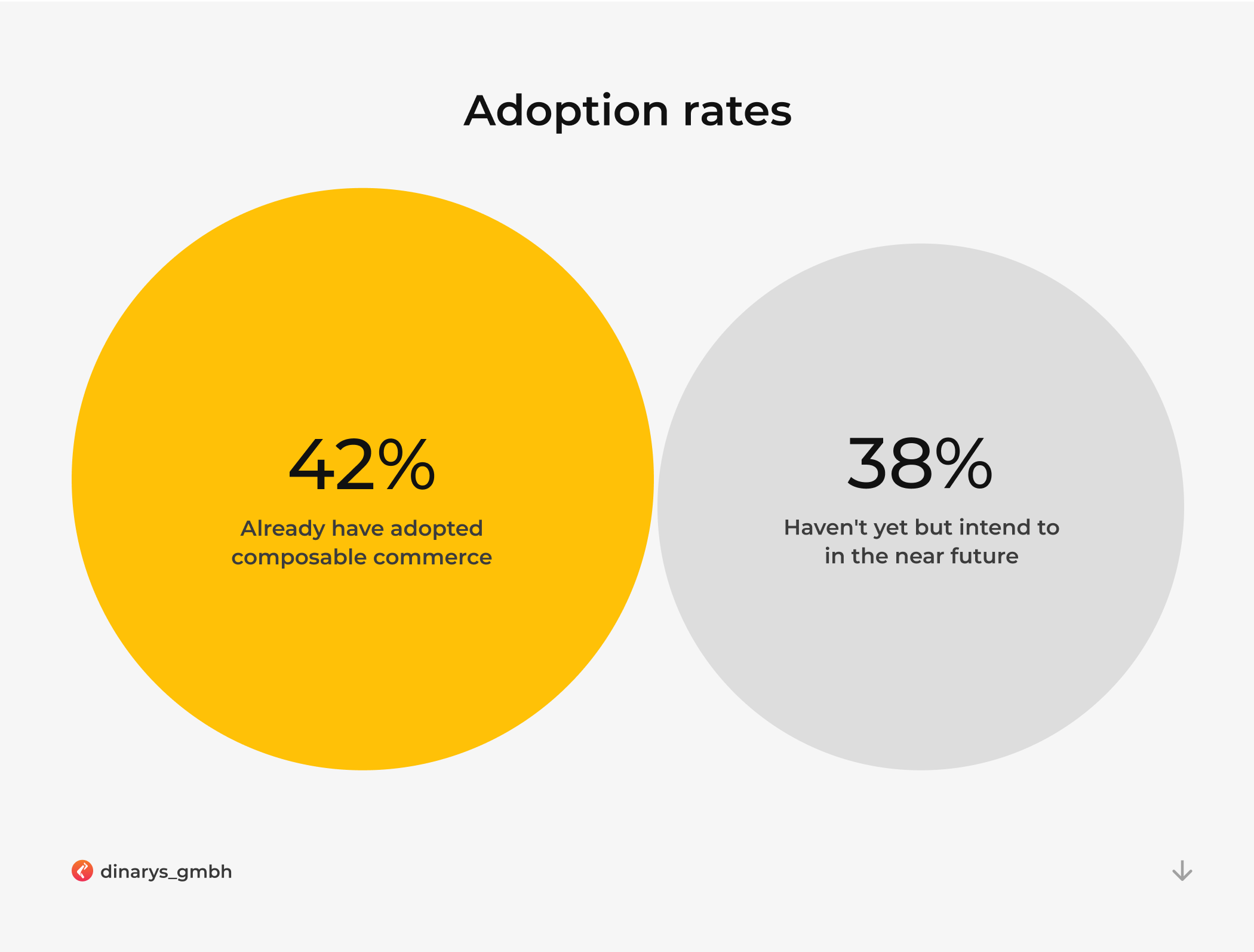
- Among those planning to adopt, 21% intend to do so within the next year, and 5% within the next two years.
Familiarity and сonfidence
- 96% of retail executives are familiar with composable commerce and indicate a strong awareness of its potential benefits.
- At the same time, only 2% of retailers claim they are fully composable, which suggests that many are still transitioning towards a composable architecture.
Strategic importance
- 71% of decision-makers consider their commerce solution strategy to have a top strategic priority.
- 96% of respondents believe composable commerce will remain a prominent tool over the next five years, while 4% express concern about whether new technologies might eclipse it.
Market growth and trends
- The headless commerce sector is projected to reach approximately $32.1 billion by 2027, highlighting the growing demand for composable solutions.
- Many organizations using a MACH (Microservices, API-first, Cloud-native, Headless) approach report seeing a positive return on investment (ROI).
Read also: BigCommerce Headless Solutions: Emprowering your ecommerce journey
Realized benefits of composable commerce
So far, retailers have reported various advantages of adopting a composable approach:
58% note improved customer satisfaction.
26% have experienced increased speed to market for new features.
27% appreciate the freedom to choose cutting-edge solutions of composable commerce platforms, which reduce the total cost of ownership.
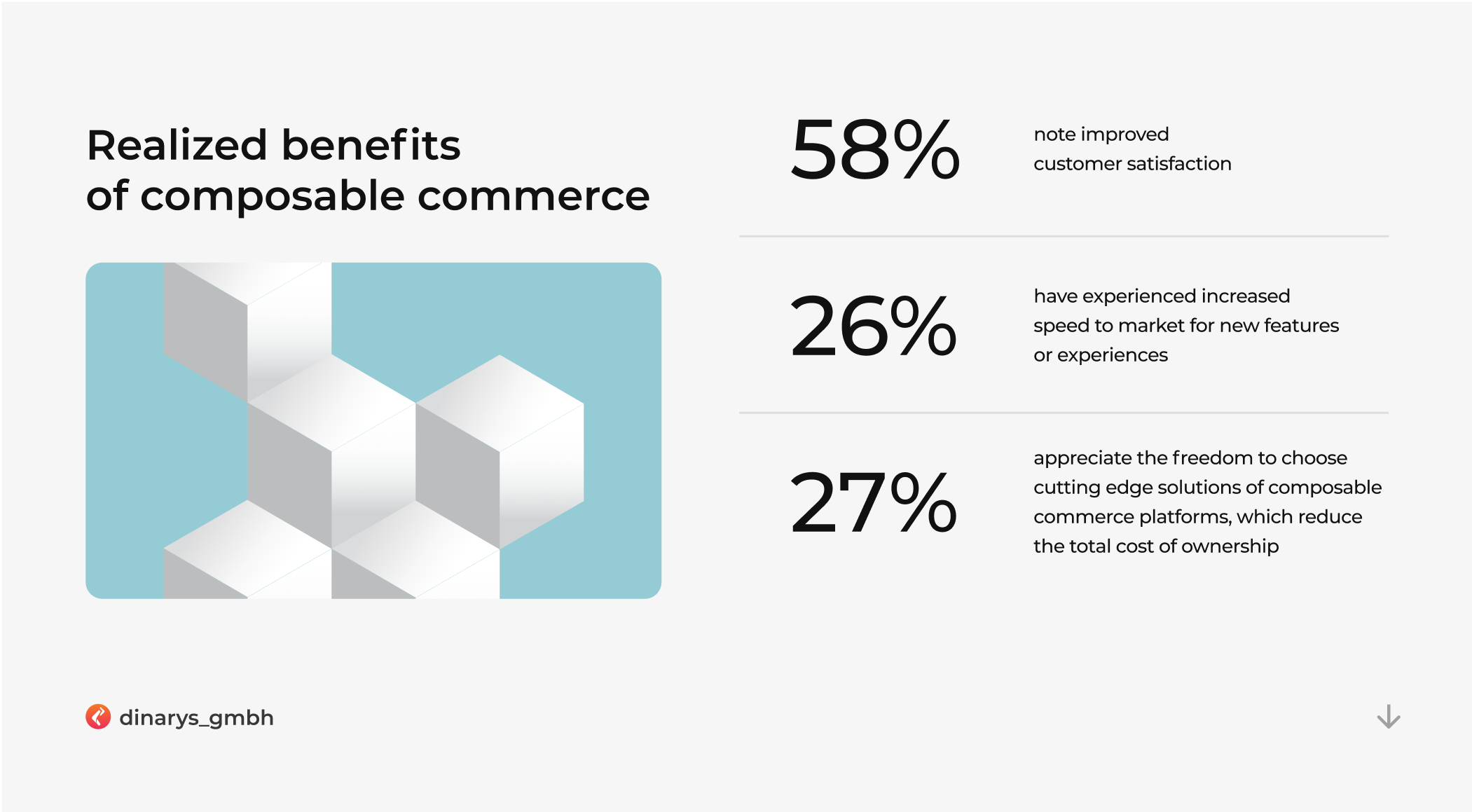
You can also discover some inspiring findings about composable commerce here.
Composable commerce and scepticism
Despite all the benefits of composable commerce, skeptics also exist. Here are some interesting statistics from a survey conducted by Alokai:
- 27% of respondents note a lack of internal knowledge or experience with a composable commerce stack
- 29% of respondents are not willing to sacrifice existing technology and investments
- 33% of respondents are afraid of navigating the budget
We’re not preachers of the composable commerce approach; however, we’re pretty sure that the improvements you will get through integration of a modular system will help you achieve your business goals much faster and enhance your customer experiences. And these benefits far outweigh the current disadvantages, which mostly are fears of new technology.
What are the global ambassadors saying?
There is another statistical aspect worth noting, presented by the MACH Alliance.
The MACH Alliance is a global advocate for modern business technology architecture and the adoption of MACH principles. Through annual surveys of global IT decision-makers, the Alliance tracks digital transformation progress across major markets, including the UK, Germany, France, and North America.
In this article, we’ll compare the Alliance’s 2024 and 2025 reports, each based on insights from over 550 technology leaders, to examine how the adoption of MACH technologies (which drive composable commerce) impacts implementation strategies and business outcomes.
Market maturity and adoption
The MACH ecosystem has reached a critical stage of maturity, with a clear distinction emerging between early adopters and those leading the way. Currently, 44% of organizations are expanding their MACH adoption, while 25% have established a mostly composable architecture:

This signals a significant transition from early experimentation to widespread implementation.
Current state
The most notable trend in MACH adoption is its rapid acceleration across industries. With just 4% of organizations still in the planning or proof-of-concept stage, it’s clear that the market has moved well beyond experimentation:
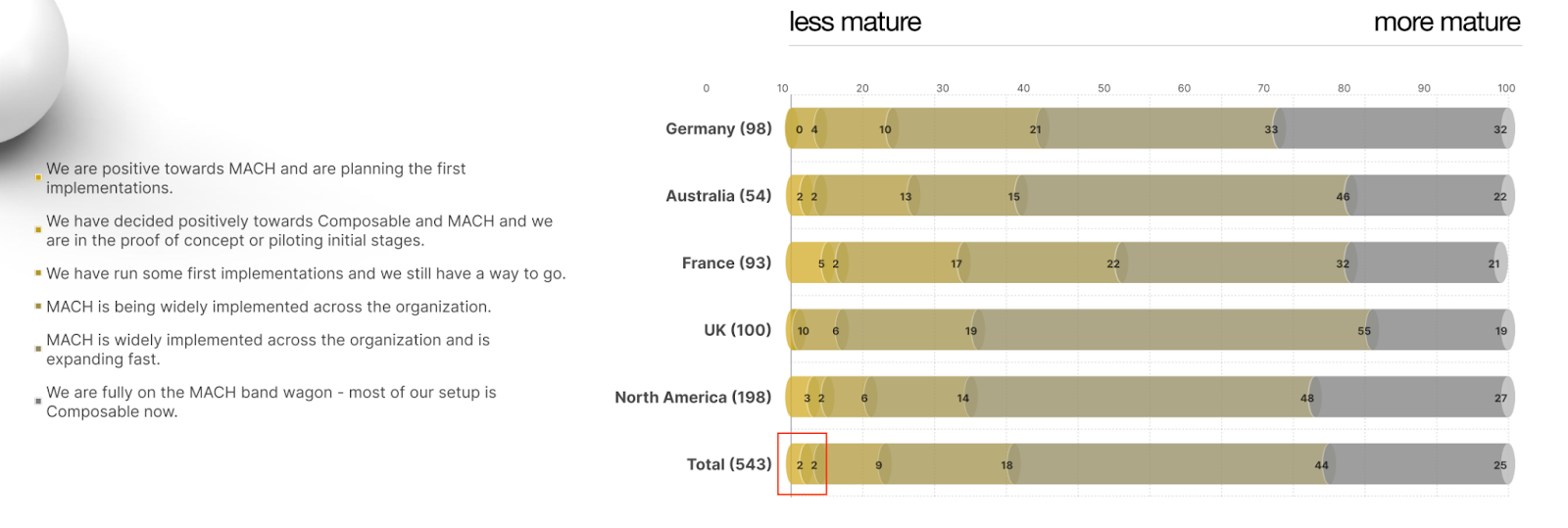
As adoption grows, so does the sophistication of implementation strategies and the clarity around its business benefits.
Year-over-year growth
The shift from 2024 to 2025 reflects significant progress in MACH adoption. In 2024, organizations with 25,000 or more employees reported a nearly even split between customer-facing (48.3%) and back-end (46.7%) MACH infrastructure:

By 2025, this balance has shifted toward more strategic implementation, with 91% of organizations expanding their MACH infrastructure:

More importantly, ROI achievement has risen, signaling that organizations are becoming more skilled at both implementing and maximizing the value of MACH technologies:

Looking ahead, 61% of organizations expect to achieve a fully composable architecture by 2026, pointing to sustained momentum in the sector.
Industry analysis
Different industries show distinct patterns in their MACH adoption journey, with some clear leaders emerging while others face unique challenges.
Retail sector leadership
The retail sector stands out as a MACH early adopter success story, with 38% of organizations having started their implementation over seven years ago. This head start has delivered measurable benefits:
- 50% of retail organizations report widespread implementation and expansion
- 23% have already achieved a fully composable architecture
- An 84% ROI achievement rate validates the sector’s early adoption strategy
However, as other industries accelerate their MACH adoption, retail’s early mover advantage is beginning to narrow.
Financial services transformation
The financial services sector offers a compelling contrast, with a more gradual but steady approach to MACH adoption. Regulatory requirements and complex legacy systems pose unique challenges, yet the sector is making clear progress:
- 79% of organizations are achieving ROI
- 72% strongly agree that MACH is critical to their future success
While adoption may be slower, the sector’s commitment to MACH is strengthening, with a focus on optimizing implementation and overcoming structural barriers.
Implementation patterns
The evolution of MACH implementation patterns reveals significant maturation in how organizations approach their digital transformation journey.
Speed and efficiency
One of the most compelling insights is the strong link between MACH maturity and operational speed. Organizations with high MACH maturity significantly outperform their peers:
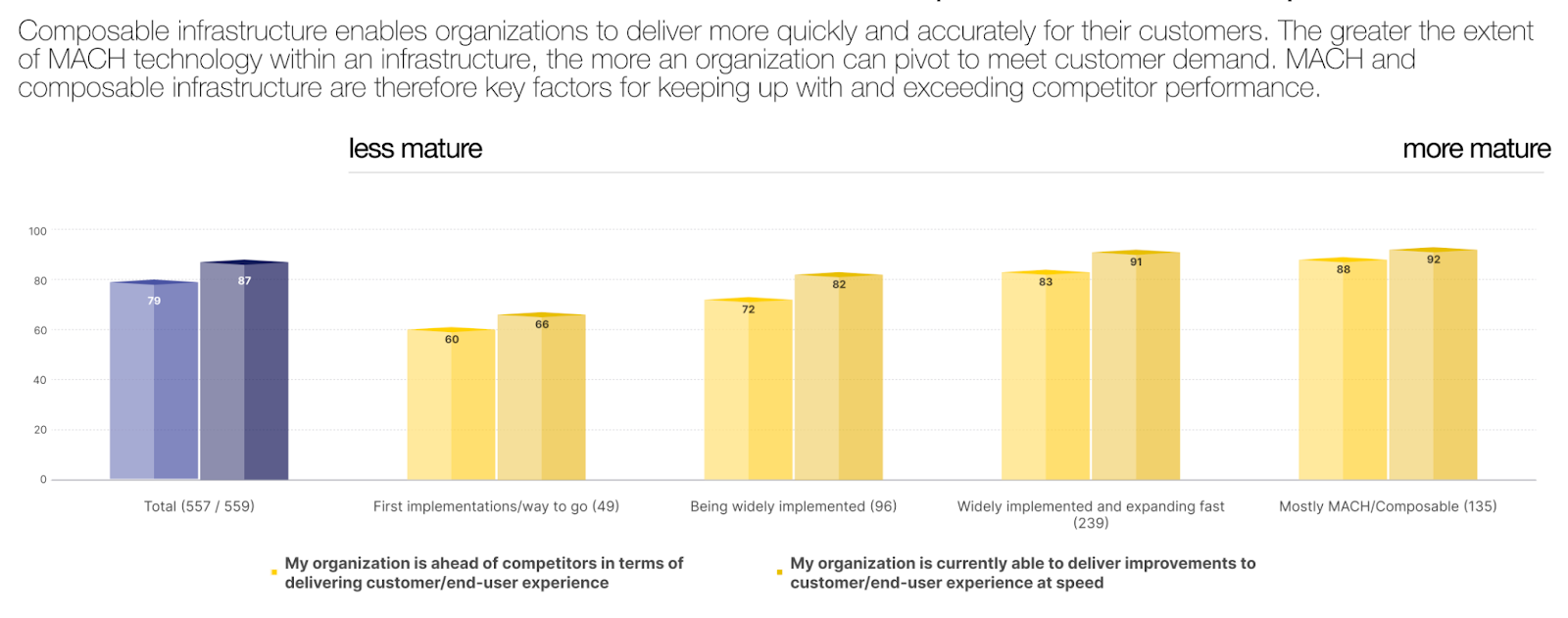
These findings suggest that MACH adoption doesn’t just improve efficiency, it creates a strong competitive edge that continues to compound over time.
Drivers behind the implementation
Organizations adopting MACH technologies highlight the following drivers:
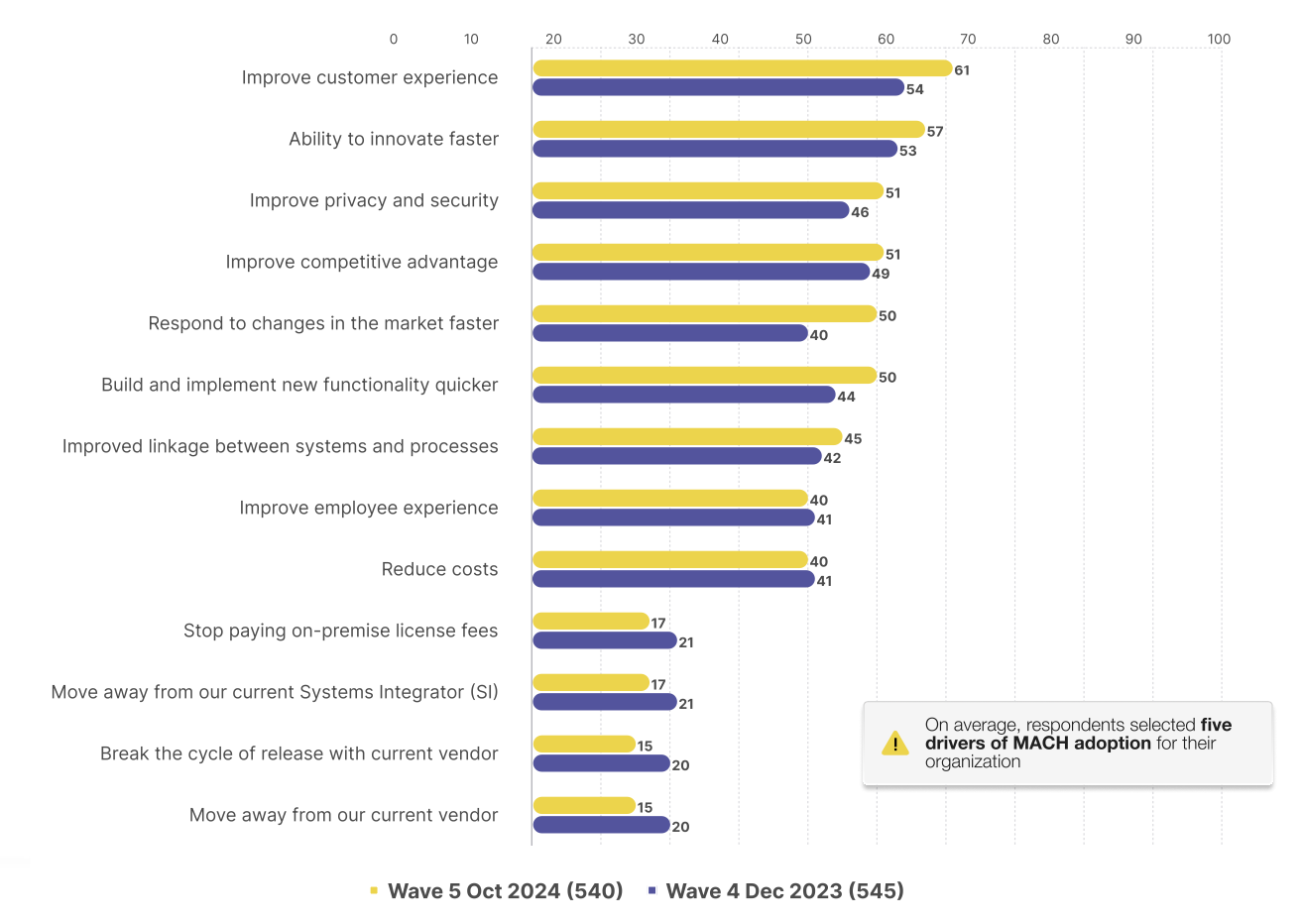
Budget allocation trends
The financial aspects of MACH implementation show an interesting evolution from 2024 to 2025.
In 2024, organizations typically split their MACH-related spending evenly, with 40% going to software and 40% to implementation.
By 2025, implementation costs have decreased to an average of 36%, indicating improving efficiency in MACH deployment.
ROI and business impact
ROI achievement
The financial success of MACH implementations shows significant improvement from 2024 to 2025. The increase in ROI achievement from 83% to 93% represents not just improved implementation efficiency, but better alignment with business objectives:
2024:

2025:
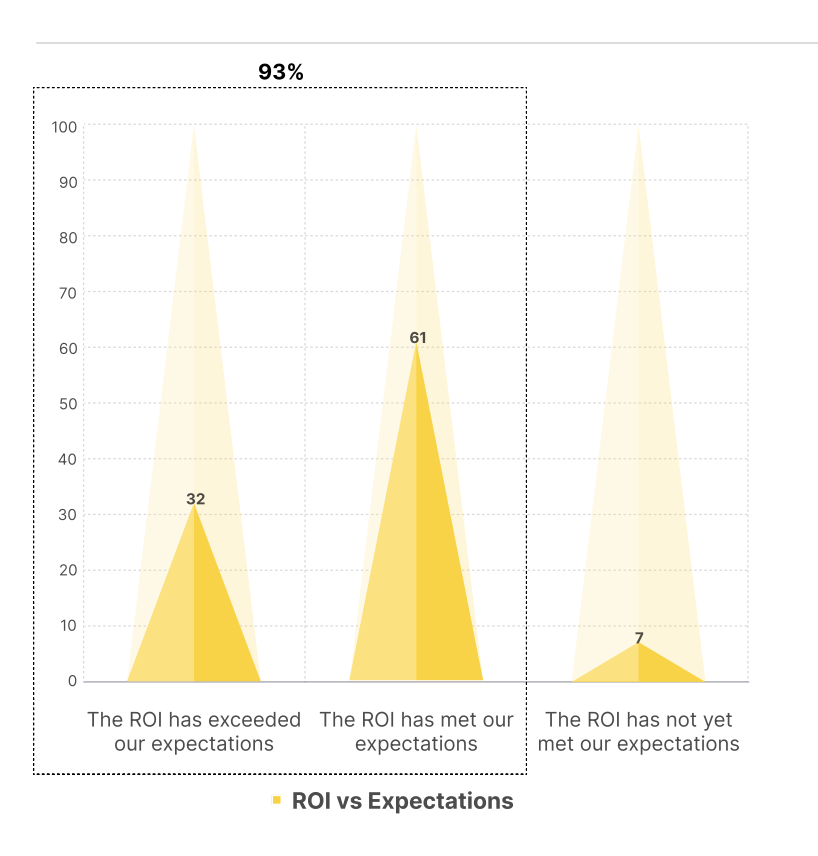
These figures suggest that while MACH implementation requires significant investment, the returns are both reliable and substantial.
Organizational impact
Beyond pure financial returns, MACH adoption is driving broader organizational change:
- 86% report improved organizational attitudes toward digital transformation
- Strong leadership support (78%) indicates strategic alignment
- High levels of implementation readiness (83%) suggest growing organizational capability
Key challenges and barriers
The analysis highlights ongoing challenges in MACH adoption, particularly tied to organizational size and the weight of legacy infrastructure. These factors can slow transformation, making it essential for businesses to anticipate and address them.
For organizations planning their MACH journey, understanding these obstacles is key to a smoother and more effective implementation.
Organization size impact
Large organizations, particularly those with over 25,000 employees, faced distinct challenges in their MACH transformation, as it’s seen in 2024 report:
- Lower adoption rates compared to smaller organizations
- Higher proportion of legacy technology requiring maintenance
- Slower implementation speeds and longer project timelines
The influence of organizational size remains consistent across both the 2024 and 2025 data, highlighting that complexity is a key factor in MACH transformation success. However, the data also indicates that large organizations making significant investments in transformation can overcome these challenges — especially when modernization is a strategic priority.
Legacy system dependencies
The burden of legacy systems creates a significant challenge for organizations undertaking MACH transformation. Organizations with more than 51% legacy systems face a particularly demanding financial equation:
- 48% of budget allocated to MACH software acquisition
- 42% dedicated to implementation costs
Future outlook
The MACH ecosystem shows clear signs of continued maturation and expansion through 2026. Several key trends emerge from the data that point to future developments:
Market evolution
The market is moving decisively toward composable architecture, with organizations expecting significant shifts in their technology stack:
- 61% expect to adopt composable architecture by 2026
- ROI achievement rates continue to climb
- Integration with emerging technologies is becoming standard practice
Integration trends
The relationship between MACH and other emerging technologies is becoming increasingly important:
- AI integration is becoming a standard feature of MACH implementations
- Organizations are focusing on broader digital ecosystem development
- Cross-technology synergies are emerging as a key benefit
Top 3 composable commerce trends for 2025
As we can see from the statistics above, 58% of business owners already benefit by embracing a composable approach, observing improved customer satisfaction. Modular components give greater flexibility, enabling organizations to more easily meet the demands of today’s fast-paced market. As companies continue to navigate digital transformation, adopting a modular approach will likely become increasingly essential for maintaining competitiveness. Here is our list of the most notable trends shaping composable commerce.
AI-driven personalization
Artificial intelligence and machine learning are key trends influencing the composable commerce landscape. Both of these technologies will revolutionize personalization and predictive analytics, bringing brand-new customer experiences.
Recommendation engines and chatbots driven by artificial intelligence are becoming more sophisticated, and machine learning algorithms are significantly improving demand forecasting and inventory management.
Key AI-powered personalization tools include:
- Nosto and DynamicYield to analyze customer behavior
- Customer data platforms (CDPs) such as Insider to combine data from multiple sources and create detailed customer profiles
- A/B testing to optimize personalization strategies
- Content personalization tools such as Optimizely to enable dynamic content delivery based on the way a user interacts with a site
- And others
Taken together, these personalization tools help composable commerce platforms to increase customer engagement, as personalized experiences lead to higher satisfaction and significantly boost conversion rates. AI and ML also let businesses efficiently scale their personalization efforts without overhauling existing systems, improving scalability.
Social commerce era
If you mix the power of influencers, branding, and social media with instant storefronts, you’ll get a social marketplace. And it seems to us that the social commerce era will be here for a long time. According to Grand View Research, Statista, and ECDB, the social commerce industry is expected to grow continuously for the next five years. The numbers in the graph below represent trillions of US dollars, so this trend is definitely worth your attention.

Key tools for social commerce include:
- Social media integration platforms like Shopify Social and Facebook Shops to create storefronts directly on social media platforms
UGC tools such as Yotpo and Bazaarvoice to help brands collect and display customer reviews, photos, and videos on their e-commerce sites - Influencer marketing platforms and tools like AspireIQ and Upfluence to facilitate partnerships with influencers and promote products through social channels
- Social Listening Tools such as Hootsuite Insights and Brandwatch for businesses to monitor social media conversations about their brands or products
- Live shopping solutions with platforms like CommentSold and ShopShops to enable live-stream shopping experiences where brands can showcase products in real time
- Personalization engines and tools like Dynamic Yield to deliver personalized recommendations based on individual preferences
By integrating social commerce into composable commerce, you’ll get enhanced customer engagement, seamless shopping experiences and increased brand awareness, cost-effective marketing with agile strategies, and improved conversion rates.
Boundless integrations
From the start, the ability to integrate third-party tools was what convinced retailers to adopt composable commerce. The simplicity of integrating independent components into an ecommerce system is the key difference between composable commerce and monolithic platforms. The emphasis on API-first integrations will continue, allowing for seamless adoption of AI and ML innovations within existing composable architectures.
Key tools for third-party integrations include:
- API management platforms with tools like MuleSoft and Apigee to facilitate the management of APIs, ensuring seamless communication between different services
- iPaaS with low code tools like Zapier and Integromat to automate workflows by connecting different applications and services
- CDPs and tools like Segment and BlueConic to aggregate customer data from various sources
- Payment gateways with solutions such as PayPal, Stripe, and Square to offer diverse payment options, providing flexibility in payment processing
- CMSs and platforms like Contentful and WordPress to manage digital content efficiently, maintaining a consistent brand voice
- Marketing automation tools like HubSpot and Marketo to analyze customer engagement across various channels
With boundless integrations, you’ll benefit from a faster time to market, enhanced customization and flexibility, cost-efficiency, access to advanced technologies, scalability, and improved customer experiences.
How can Dinarys help you with fostering innovation?

To make it less intimidating to get started, we want to give you a quick tour of implementing a composable commerce architecture. If you work with Dinarys specialists to implement composable commerce in an existing online store, the steps will look like this:
1. Analyze current needs and infrastructure. First, we will study your existing system, identify its strengths and weaknesses, and understand what business goals or specific needs you seek to meet with the new solution. This will help us to draw up an individual migration plan, choose ready-made solutions that precisely fits your tasks, and determine where ready-made solutions will not cover your needs and it is better to create custom solutions.
2. Develop a migration strategy. Based on our analysis, we’ll develop a detailed transition plan, selecting optimal components, determining the migration sequence, and distributing roles between teams. We’ll also consider factors such as budget, scalability, technological requirements, and integration with existing systems.
3. Migrate data. Next, we will carry out a planned data migration from the existing system to the new system. We’ll carefully plan the migration and test data consistency to avoid data loss.
4. Integrate with existing systems. Finally, we will seamlessly integrate the new solution with your ERP, CRM, payment system, etc.
5. Test and optimize. After migration, we’ll test all functions of the new solution to ensure they work and that the solution meets your specific business needs.
6. Provide support and development. We prefer to provide a turnkey service. If necessary, we can provide long-term support, helping you adapt to your new solution and develop it according to your changing business needs. We also offer staff training as needed so your team can learn how to effectively use new composable commerce capabilities. This knowledge will help you to stay competitive and encourage customer loyalty.
Conclusion
Growing demand among business owners for flexibility and agility in ecommerce platforms makes the future of composable commerce quite promising. The pace of adoption among digital commerce platforms is expected to continue growing. Going beyond headless commerce, the modular nature of composable commerce allows it to exceed customer expectations. While 2025 will likely not be a year of radical change for composable commerce, it will definitely be a year of further adoption. So, are you in?
Let professionals meet your challenge
Our certified specialists will find the most optimal solution for your business.



